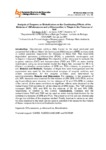Use este identificador para citar ou linkar para este item:
http://www.alice.cnptia.embrapa.br/alice/handle/doc/1071398Registro completo de metadados
| Campo DC | Valor | Idioma |
|---|---|---|
| dc.contributor.author | DANTZGER, D. D. | pt_BR |
| dc.contributor.author | JONSSON, C. M. | pt_BR |
| dc.contributor.author | AOYAMA, H. | pt_BR |
| dc.date.accessioned | 2017-08-01T23:50:33Z | - |
| dc.date.available | 2017-08-01T23:50:33Z | - |
| dc.date.created | 2017-06-23 | pt_BR |
| dc.date.issued | 2016 | pt_BR |
| dc.identifier.citation | In: REUNIÃO ANUAL DA SOCIEDADE BRASILEIRA DE BIOQUÍMICA E BIOLOGIA MOLECULAR, 45., 2016, Natal. Anais... Natal: Sociedade brasileira de bioquímica e biologia molecular, 2016. | pt_BR |
| dc.identifier.uri | http://www.alice.cnptia.embrapa.br/alice/handle/doc/1071398 | pt_BR |
| dc.description | Introduction. Oreochromis niloticus (Nile tilapia) is the most produced and consumed fish in Brazil. Many fish farming use Diflubenzuron (DFB) as insecticide to control parasites responsible for diseases in these fish. This insecticide degradation generates p-chloroaniline (PCA), a potentially carcinogenic and mutagenic compound. Objectives The objective of this study was to evaluate the enzymes catalase (CAT) and transaminases (TGO and TGP) as water toxicity bioindicators using as experimental model the tilapia fish, exposed for 96 h to different combinatory concentrations of DFB and PCA mixtures, in presence of soil. Material and Methods. Samples of tilapia liver were homogenized and the supernatant was used for the biochemical analyses of enzyme activities and protein concentration. All the enzyme activities were determined by spectrophotometry. Results and Discussion. For catalase, in the presence of soil, 80% decrease was observed for the mixture of 25% DFB (75% PCA) and no significant effects were observed for the mixtures of 50 and 75% DFB, in relation to the control. At the same conditions no significant effects were observed on the transaminase TGO activities for all the mixtures of DFB tested. The TGP activities increased 350%, 80% and 60% for the mixtures of 25, 50 and 75% DFB, respectively, in relation to the control. Conclusions. Catalase and the transaminases TGO and TGP can be used as water toxicity bioindicators for the combinatory mixtures of DFB and PCA. The presence of the soil can dramatically change the activities of the enzymes studied. Finally, besides to serve as an alert, the data obtained in this work can be used to establish limit values for the mixture of these compounds in tropical freshwater bodies. | pt_BR |
| dc.language.iso | eng | eng |
| dc.rights | openAccess | eng |
| dc.subject | P-chloroaniline | pt_BR |
| dc.subject | Bioindicators | pt_BR |
| dc.title | Analysis of enzymes as bioindicators on the combinatory effects of the mixtures of diflubenzuron and p-chloroaniline in tilapia in the presence of soil. | pt_BR |
| dc.type | Resumo em anais e proceedings | pt_BR |
| dc.date.updated | 2017-08-01T23:50:33Z | pt_BR |
| dc.subject.thesagro | Enzima | pt_BR |
| dc.subject.nalthesaurus | Diflubenzuron | pt_BR |
| riaa.ainfo.id | 1071398 | pt_BR |
| riaa.ainfo.lastupdate | 2017-08-01 | pt_BR |
| dc.contributor.institution | D. D. DANTZGER; CLAUDIO MARTIN JONSSON, CNPMA; H. AOYAMA. | pt_BR |
| Aparece nas coleções: | Resumo em anais de congresso (CNPMA)  | |
Arquivos associados a este item:
| Arquivo | Descrição | Tamanho | Formato | |
|---|---|---|---|---|
| dantzeranalysis.pdf | 36,05 kB | Adobe PDF |  Visualizar/Abrir |









